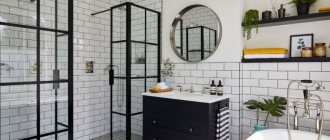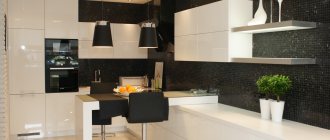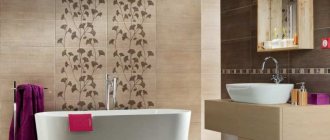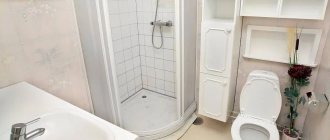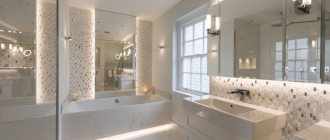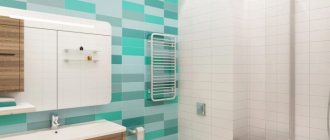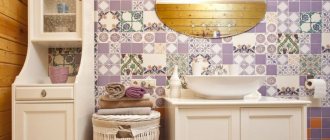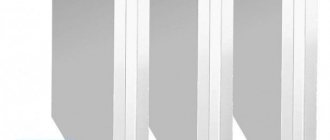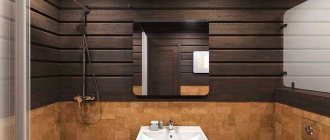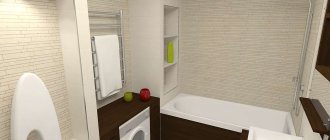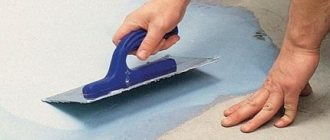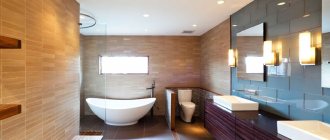What types of tiles are used to decorate a bathroom?
Depending on the raw materials and manufacturing technology, there are several types of tiles that are used for finishing:
- Ceramic tile.
- Ceramic granite – porcelain stoneware.
- Glass tiles, or mosaic.
- Clinker.
- Natural stone tiles.
Ceramic tile
It is made from red or white clays with the addition of feldspar and quartz sand. The ceramic tile production process is multi-stage. It consists of grinding and mixing components, removing moisture from the mass, and firing in high-temperature furnaces at 1000–1250°C. Depending on the method of molding the raw mass: whether it was cast into blanks, pressed, squeezed out of molds by extrusion - samples of tile material are obtained with different properties, configurations and sizes.
Bathroom finished with ceramic tiles.
Ceramic tiles are the most popular finishing material used in bathroom renovations.
Ceramic granite
This facing material is also made from clay, but has nothing in common with natural granite. It received its name due to its increased strength and the similarity of the granular surface of some samples to stone. Porcelain tiles are made from rare kaolin clays, which produce a dense material.
First, the dry raw materials are crushed to fine dust: the smaller the particles, the denser the porcelain tile will be. Then the crushed clay goes under the press. Pressing occurs under higher pressure - up to 500 kg/sq. cm, and firing at elevated temperatures – 1200–1300°C. Due to the absence of pores and high density in the body of porcelain stoneware, its water resistance, temperature resistance and wear resistance are increased.
Bathroom finished with porcelain stoneware.
Excellent consumer properties have expanded the scope of use of porcelain stoneware. It is used not only for interior work - finishing a bathroom, shower room, toilet, kitchen, but is also excellent for outdoor use - laid on terraces, garden paths.
Due to its properties and beauty, porcelain stoneware is excellent for finishing a bathroom, but its high cost stops many buyers.
Glass mosaic
Glass mosaic.
Glass mosaic is made from the same raw material as regular glass - quartz sand, which is melted to a liquid state, and then shaped and cooled. To impart the desired properties and color, various substances are added to the mass. Since the size of individual elements is much smaller than traditional tiles, for ease of installation they are produced on a cardboard base or on a polymer mesh, where fairly large areas are combined.
Bathroom decorated with mosaics.
Glass has excellent waterproof properties, so glass mosaic is suitable for decorating the walls of wet rooms and has an excellent aesthetic appearance.
Clinker tiles
Clinker is a more durable and practical ceramic material, but it is more often used for outdoor work. The material is made from rare hard types of clay, the deposits of which are limited. There are no raw materials for clinker production in Russia, so it is imported from abroad. Before processing, the clay is carefully sorted - it should not contain any impurities.
Then the raw material is moistened and shaped by extrusion - squeezed through molds. High temperature firing – at temperatures above 1200°C. The result is a highly durable tile material with excellent technical characteristics.
Clinker tiles.
The main advantage of clinker is excellent vapor permeability combined with moisture resistance and low moisture absorption. In practice, this means that even the smallest vapors that penetrate the pores of the cleaner do not harm the tiles, since they do not accumulate inside, but come out. Therefore, clinker is often used for outdoor work - it is more frost-resistant, does not accumulate moisture, and will not burst at sub-zero temperatures after many years of use.
Bathroom finished with clinker tiles.
There are varieties of clinker for internal use; this material is used for finishing bathrooms, which allows you to turn various design ideas into reality. But most often this type of tile is used when decorating loft-style bathrooms.
Natural stone tiles and mosaics
Natural stone tiles.
Natural stone tiles are beautiful, environmentally friendly and prestigious. It is waterproof, durable, resistant to household chemicals. Significant disadvantages of the material are its heavy weight and high price, due to which not all people can afford finishing with natural stone. The best option for replacing natural materials is ceramic tiles or porcelain stoneware with a stone-like pattern.
Bathroom finished with natural stone.
What types of tile surfaces are used in the bathroom
Depending on the type of surface, tiles come in the following types:
- glossy;
- matte;
- embossed.
Glossy tiles
Glossy samples are smooth, with a pronounced shine. They reflect light rays and fill the room with light. But lovers of glossy shine should take into account that water stains and traces of splashes are clearly visible on such a surface. After installing the lamps, glare appears on glossy tiles, which does not always look aesthetically pleasing, so this nuance should be taken into account when setting the light.
Glossy tiles in the bathroom.
Matte tiles
Matte ceramics create a more noble interior as it softly diffuses light. On a matte surface, dirt is less noticeable; water stains, drops, and splashes are not visible. However, cleaning such facing material will require more effort. Since the matte surface slips less, it is preferable for floor finishing.
Matte tiles in the bathroom.
Relief tiles
Embossed tiles create a bizarre play of light and shadow, but at the same time their care is complicated. Experts recommend using relief tiles in the bathroom in limited quantities - to create panels, decorative inserts, etc.
Relief tiles in the bathroom.
What qualities should tiles for bathroom walls and floors have?
Unlike tiles laid in public spaces, tiles used for bathrooms do not have increased requirements for thickness, strength and wear resistance.
All bathroom tiles can be divided into two categories: for walls and for floors. Since the load on these two surfaces is different, the tile material must have different properties.
There are several general requirements for tiles used in the bathroom:
- Moisture resistant.
- Resistant to household chemicals.
- High-quality processed front surface.
Moisture resistant. Ordinary ceramic tiles have high water absorption, which is why they are not used for exterior decoration. Since when moisture trapped inside the tile freezes, the material will be destroyed. In the case of the bathroom, such processes are not observed. Therefore, ordinary ceramic tiles are widely used in this room, since they can very easily both accumulate and release moisture. In addition, the outer layer of the tile does not allow moisture to penetrate into the inner layers.
Porcelain stoneware, which has a low water absorption coefficient and does not accumulate moisture, performs best in terms of moisture.
Resistant to household chemicals. Consumers are accustomed to the fact that tile is an easy-to-care, moisture-resistant, unpretentious material that can be easily cleaned of dirt using standard detergents. Meanwhile, all types of ceramic products react differently to aggressive chemicals.
If you do not take this factor into account when choosing and purchasing a material, you may encounter the fact that the surface will eventually become covered with cracks, discolored, and the protective and decorative glaze will become covered with fine cobwebs.
Front surface. The front side of the tile should be evenly covered with glaze, impeccably smooth, without inclusions, swelling, or roughness. Any type of defect is excess moisture inside the tile. If for any other room minor surface defects are not important, they are invisible and do not affect the service life of the tiles, then for a wet room, a violation of the integrity of the top layer means increased moisture absorption.
Choosing tiles for bathroom walls
Wall and floor tiles have different requirements. On the packaging of tiles intended for wall mounting, manufacturers place a drawing of a hand or palm.
Basic requirements for such tiles:
- Have a minimum water absorption coefficient.
- Be resistant to chemically aggressive substances.
- The geometry of the forms must be flawless.
Tiles laid on walls serve only a decorative role, so you should not use expensive and durable modifications of tiles for walls. For domestic use, double-firing ceramic tiles of I-II wear resistance class are sufficient. This is a budget material, but it resists detergents well and can last for many years.
Naturally, you can use other types of tiles to decorate walls, including porcelain tiles and mosaics, but the cost of these products and subsequent installation will cost you more.
Choosing tiles for the bathroom floor
Floor tiles have different requirements, since the floor in the bathroom experiences the main loads.
- High wear resistance. According to wear resistance, tiles are divided into 5 classes: the first is the minimum degree, the fifth is the maximum. The wear resistance class is indicated on the packaging by the Latin letters PEI with Roman numerals. Bathroom floors require products marked PEI IV–V.
- Good anti-slip effect. For an anti-slip effect, notches are applied to the surface, a relief is made, and roughness is formed. Western manufacturers label non-slip products with the word “Grip” indicating the class. The angle of inclination at which the anti-slip effect of the tile is maintained is indicated by the letter R: R6–9.
- Strength. The thicker the material, the stronger it is. As a rule, floor tiles are produced by the manufacturer in a thickness greater than wall tiles - 9–15 mm.
- High level of bending resistance.
- Resistance to abrasive and chemically aggressive substances.
For the floor it is best to use:
1. Single fired ceramic tiles are a very durable and wear-resistant material.
The floor is finished with single fired ceramic tiles.
2. Porcelain stoneware - has increased strength and wear resistance; it is sufficient for use in a bathroom.
The floor is finished with porcelain stoneware.
What color of tiles to choose for the bathroom
At the moment, all manufacturers of ceramic tiles have in their assortment ready-made collections intended for installation in the bathroom.
Typically the collection includes:
Light colored tiles.
Decorative tiles.
Dark floor tiles.
Border.
Tiles with a transitional tone from light to dark.
Floor tiles.
Therefore, if you are not confident in your sense of color and do not want to involve a specialist in your choice, then you can trust the manufacturer’s designers.
The choice of color largely depends on the tastes and preferences of the home owners. But there are general fashion trends, and the advice of interior designers will help to visually expand or narrow the space and make the interior stylish.
Bathroom tiled with the tile collection shown above.
Bright light colors
White, grey, beige and other light shades are very popular lately. They are especially relevant in small bathrooms, as they allow you to visually expand the space. In addition, white is a universal color - it is an excellent background for decor, furniture, and bright accessories. Walls decorated with white tiles always look fresh, shine with cleanliness, and never get boring.
Dark colors
Dark colors - black, graphite, dark purple, dark blue and others - are considered noble. Experts recommend using them if the bathroom area is large, as dark colors visually make it smaller. It would be ideal if, along with the dark tiles, the room would be properly illuminated, which would give it a romantic touch and relieve the gloom. Also, a dark spectrum of finishing will help out when the apartment has a complex layout and the geometry of the room is not ideal - it will hide the shortcomings.
Black
Noble black color stands alone among the tones of the dark spectrum. With a competent approach to decorating a bathroom, it looks impressive, luxurious and noble. It is better to decorate the walls with black tiles in large bathrooms, complementing the design with mirrors and lighting, since dark tones absorb light.
Today, manufacturers paint tile materials in all shades of black: ebonite, charcoal, raven's wing, blue-violet, blueberry, prune. You can combine them with contrasting inserts of light shades. Spectacular black tiles are also practical - drops from splashes, soapy water stains, and dirt are not visible on them.
Green
Green is a life-affirming color. According to psychologists, it has a beneficial effect on the psyche - it calms without suppressing emotions, and creates an uplifting mood. When combined with wood trim and furniture, greenery creates a feeling of living nature, naturalness, and freshness. There are many shades of green: light green, mint, menthol, fresh herbs, bamboo, grassy, emerald, coniferous. Each of them will bring into the room an atmosphere of joy, freshness, and life.
Blue
Blue is the color of water, so I often use it to decorate bathrooms and shower rooms. It belongs to cold tones, brings a feeling of freshness to the interior, creates a calm emotional state, and increases tone. Most people like shades of blue: turquoise, clear water, sea green, pearl, opal, aquamarine, sky blue, porcelain, tourmaline.
They all look great paired with the versatile white color. Whatever material is used for interior decoration: wood, metal or plastic, it will harmoniously combine with blue tiles.
Milky shade
This is a variation of the classic white color. Using milky-colored tiles in the interior will visually expand the space, bring light and cleanliness into the room, and allow you to escape the operational rigor of a pure white surface. Milk goes well with all other colors, and when combined with shades of black, the interior will look luxurious, expensive, and respectable.
Orange
Orange is the life-affirming color of the sun. A catchy orange bathroom design will appeal to young, energetic people. A bright interior will look unconventional, bold and original. Moreover, there are at least a hundred shades of orange of varying degrees of brightness, from which even very conservative people can choose the right one for themselves.
The following shades are considered varieties of orange: flesh, peach, almond, apricot, powder color, amber, pumpkin, ocher, carrot. Each of the shades can be creatively used in a modern interior, moving away from the excessive brightness of orange.
Turquoise
Turquoise, like blue, is one of the frequently used colors for bathroom decoration, as it allows you to play up the marine theme. It is warmer than blue and promotes relaxation. The use of turquoise tiles will allow you to create wall compositions in the bathroom on the theme of summer holidays, games of sea creatures, and add a touch of aquatic freshness. Turquoise combines well with shades of white, blue, and green.
Blue
Blue is a strict, cold color that is rarely used without diluting it with white, blue, turquoise, milky or creamy tones. Designers recommend using blue with caution. With a skillful combination of colors, the use of blue will allow you to decorate the interior in a bold, original, unconventional way.
Lilac
Lilac is a pleasant color; it looks impressive in combination with white, black, or when using several tones of different intensities. Lilac color goes well with dark eggplant or light pink tones. To add elegance to the interior design of a bathroom, shower, or toilet, you can use mosaics on the walls with several shades of lilac. Today, pink, coral, and flamingo colors are becoming fashionable.
Yellow
Sunny yellow will appeal to energetic, life-loving people. It fills the room with light, increases tone, improves mood. People especially miss the warmth of yellow in winter, so decorating a room using it will add positivity to life. Yellow goes well not only with basic white and black, but also with blue, blue, green, red, creating bright combinations.
There are many shades of yellow: honey, banana, wheat, mimosa, lemon, amber, sunflower, turmeric, saffron, straw. Each of the tones in combination with other colors will create a colorful interior. Eco-style, which often uses natural shades of yellow: honey, wheat or amber, is becoming especially popular today.
Style selection
The style of the bathroom should support and organically complement the style of the entire apartment or house. Let's look at the most trendy trends in bathroom design.
5.1 Classic style
Calacatta Royal
The classic style is characterized by symmetry and clear geometry. White, dark brown, beige and pastel colors dominate here. The central place here is occupied by the bath. In the classic interior style, preference is given to natural types of materials and their combinations: marble, wood, gilding, silver.
5.2 Minimalism
Spring
Minimalism is one of the varieties of modern style that is at the top of trends today. A restrained range of colors is used here. Slabs of monochrome color or with geometric decors and ornaments are suitable here. 3 shades of color are allowed.
5.3 Loft
Loft
A variation of the modern industrial style called loft remains popular in bathroom design. This minimalist style combines cladding with different textures. Effective combinations are provided by “hog-shaped” brickwork, slabs with a concrete surface, metal-type porcelain stoneware surfaces and aged wood coverings.
5.4 High-tech
Prime
The high-tech style is formed by strict, clear colors, emphasizing the utilitarianism and pragmatism of this design direction. The predominant slabs here are white, gray, and black with accents in the form of blue, red, yellow, and green. Chrome details, symmetry, angular geometry, minimalism – these are the elements inherent in this style. Tile cladding is suitable here, reproducing metal and black wooden surfaces.
5.5 Provence
Sweep
The canons of rustic styles such as Provence and country allow the use of natural color combinations. Light beige, blue, lemon, lilac shades of slabs in combination with milky white background slabs are suitable for Provence. Combinations of dark and light wood with marble are allowed.
5.6 Country
Country
In country style, wood becomes the predominant element. This material successfully imitates ceramic granite with a structured surface. Combinations of shabby and aged finishes are also suitable for country style. Both of these styles feature floral decors.
5.7 Eco-style
Focus
Wood and decorative elements of living nature are considered the main component of eco-style slabs.
Tile pattern and relief
Drawing. When choosing tiles with a pattern, you need to take into account all the nuances: the area of the bathroom, the height of the ceiling, the amount of furniture, the location of plumbing units. In small and large rooms, small and large patterns will look different.
In small rooms, pictures the size of one tile or small, not bright pictures assembled from several tiles look best. In small bathrooms, you should avoid using large solid panels, as they visually bring the wall on which they are located closer.
Relief. There should not be too many relief tiles in the bathroom. It should not be used to decorate the entire surface of the walls, but only used as accents.
Introduction
Each of us, wanting to improve the appearance of our bathroom, is faced with the choice of finishing ceramics. We want this room in the house, like no other, to evoke only positive emotions in us. Therefore, you need to take a responsible approach to choosing tiles.
A successful choice of cladding for a bathroom consists of the following components:
• Selecting a material • Selecting a size • Selecting a surface type • Selecting a style • Selecting a color • Selecting a manufacturer • Calculating the number of tiles
If, when choosing cladding for a bathroom, you break down this issue into the following points, it will be much easier for you to make the right final choice in the end.
Tile size and shape
Another important aspect of choosing bathroom tiles is their size and shape.
Square. It is easier to lay, and it is easier to adjust elements to one another than products of other shapes. If there are problems with the geometry of the walls, then purchasing square tiles will solve the problem.
Rectangle. Rectangular ceramic tiles are often used to decorate the bathroom. Its popularity is explained by the fact that bathrooms are most often small in size, and horizontally laid rectangular tiles help visually expand the space. Vertically oriented stripes will visually lift a low ceiling.
Non-standard shapes: honeycombs, hexagons, triangles, rhombuses. A surface tiled with irregular shapes looks impressive, especially if individual elements differ in tone. But in order for all the elements to fit perfectly, their geometry must be flawless. Therefore, experts recommend buying non-standard shaped tiles produced by well-known European factories.
Mosaic. Gives the interior charm and exclusivity. Looks better in large areas and volumes.
In small rooms you should not use small tiles. The best solution for a bathroom would be tiles with dimensions of 400×275 mm, 600×300 mm, 500×200 mm. They will help to expand the space, but will not cause a feeling of pressure and will not ripple in the eyes. The size of the tiles depends on the geometric features of the room: if the bathroom is rectangular, then it is recommended to use products of the same shape for finishing.
Finishing with large-format tiles results in fewer seams, and the room decorated with them looks more noble. Large samples are more expensive. Properly sized tiles in the bathroom can significantly improve the perception of space.
Which tile laying patterns are suitable for the bathroom?
The tile laying pattern is not only a matter of skill of the tiler. An experienced craftsman will accurately suggest the best option, but the customer has to think about this when planning repairs, selecting and purchasing materials. Therefore, the average consumer should know the basic layout methods:
Direct laying without moving elements
The simplest traditional method is when the elements are mounted sequentially in a row, vertically installed one above the other without displacement. The result is a neat classic pattern - a mesh.
Direct tile laying pattern.
Straight laying with offset
This is a classic method, reminiscent of brickwork. Depending on the type of displacement, the pattern turns out different: the shift of elements in a row relative to the previous one can be half an element, a third or two thirds. Best used on plain walls.
Laying tiles with offset.
Christmas tree
This scheme is also called linear-angular. The elements are also laid in a line, but at an angle of 45 degrees. The result is a recognizable “Christmas tree” pattern. Laying in this way allows you to visually increase the height of the ceiling.
Herringbone tile laying pattern.
In practice, professional craftsmen use many more techniques for laying out tiles: braided, linear-angular at an angle of 90 degrees, block, modular, checkerboard.
Manufacturer's choice
Over the past decades, domestic manufacturers have been making tiles that successfully compete with European companies. All large factories have acquired expensive equipment and have technologies that allow them to produce tile cladding according to European standards. This is evidenced by documents that confirm compliance with GOST standards and European level certification. When selecting tiles, the main thing is to turn to trusted brands. Companies that have established themselves in the market will not produce low-quality ceramics. Such manufacturers value their own reputation and try to take into account the wishes of customers.
How to check tiles when purchasing
When choosing ceramic tiles, buyers focus on the brand, country of manufacture, technical and dimensional parameters, color and pattern. However, in addition to this, when purchasing, you must carefully study the information on the packaging and perform a visual inspection of the samples.
You should pay attention to the following parameters:
- Geometric accuracy of the tile shape.
- Density of ceramic structure.
- No defects on the front side.
More details on how to determine, during inspection, whether the parameters specified in the accompanying documentation for the product correspond to the real ones, are described below.
Geometry
To understand how accurate the geometric shapes of the tiles are, you should compare several samples from different packs. To do this, you need to take one sample from each pack and attach them with the back side one to the other. Tile samples must fit tightly together, the gap should not exceed 0.5 mm. If you lay out 5-6 tiles from different packs in a row, the difference in height should also not be more than 0.5 mm. Tile products from Western European manufacturers, as a rule, pass this test. The geometry of Italian, German, and Spanish tiles is exemplary.
Structure density
The density of ceramics is visually determined by looking at the reverse side. Its moisture absorption depends on the density of the tile. The higher the density of the material, the less moisture it absorbs. The water absorption coefficient is indicated by the manufacturer in the accompanying documentation, but to control it, you should inspect the back side of the tile.
High-density material is smooth to the touch, without large visible pores. There should be no more than ten small pores throughout the entire sample. If the density of the tile is small, then many pores will be visible on the back side. Such tiles will quickly absorb a critical amount of moisture, become heavy and may move away from the wall.
Front surface
The ideal surface of ceramic tiles for the bathroom is important not only because of the beauty of the appearance - it ensures durability. There should be no obvious defects on the front side: air swellings, bubbles, open pores, small cracks, tiny cobwebs. If the tile is glazed, there should be no chips at the corners and ends. Any damage to the glaze means that the tile will absorb moisture and fall off after 2-3 years of use. To examine the front surface, it is enough to selectively remove several samples from different packs.
User voting
Which bathroom tiles would you choose or recommend?
ITALON
14.29 % ( 3 )
KERAMA MARAZZI
14.29 % ( 3 )
KERRANOVA
4.76 % ( 1 )
Feldhaus Klinker
0.00 % ( 0 )
Cerrad
9.52 % ( 2 )
Ceramicas Aparici
14.29 % ( 3 )
Pamesa
9.52 % ( 2 )
Saloni
4.76 % ( 1 )
FAP CERAMICHE
9.52 % ( 2 )
VENIS
9.52 % ( 2 )
CERSANIT
4.76 % ( 1 )
